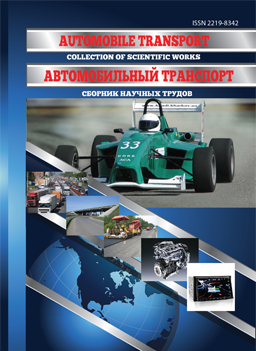Information technology for remote forced vehi-cle speed limits to improve road safety
DOI:
https://doi.org/10.30977/VEIT.2020.17.0.54Abstract
Problems. Overcoming the consequences of traffic accidents places a heavy burden on the country's health and social services. The International Transport Forum has developed the report “Striving for Zero: High Tasks and a Systematic Approach to Traffic Safety”. Forum experts consider non-compliance with the high-speed regime on roads to be a key problem in the growth of road accidents, and the use of information technologies is one of the ways to reduce accidents. Goal. Based on the analysis, we formulated the goal of the study, which consists in creating a method and device for remote forced speed limits (RFSL) of vehicles on roads in the city and outside it in accordance with the speed limit adopted at this place. The task of this article is to formulate a concept for improving road safety in Ukraine in terms of bringing vehicle speeds to the maximum allowable values for these roads (the concept is outlined and justified), as well as developing a functional diagram of a device for remote forced vehicle speed limitation. Methodology. The analytical method is research of existing systems that can remote forced speed to limit. The method of synthesis is creation the structural scheme of a new system, based on the advantages and disadvantages of analyzed systems. Results. A method of improving road safety by remote forced speed limits of cars on roads within the city and outside them in accordance with the accepted speed limit in this place is the constant transmission over mobile networks or any other communication signal carrying information about the restrictions speed in a specific place on a specific highway. This signal after reception is processed in the microprocessor control system of fuel supply to the car engine according to a certain algorithm for the purpose of maintenance of a car speed, which does not exceed the value of restriction. Moreover, the driver of the vehicle could not, even if he wanted to, compromise such a restriction. Originality. The method of remote forced speed limitation of the car works as follows. The GSM receiver (possibly another radio receiver) constantly receives a signal that carries the value of the speed allowed on this road. In a microprocessor control unit (MCU), this value is compared to a signal from a digital speedometer or speed sensor, which is the current value of the vehicle speed. The inconsistency of these two signals or exceeding the speed of the car over the allowable speed on this road is the basis for recalculation (reduction) according to the programmed algorithm by the MCU unit of the amount of fuel required to feed the injector, as well as to reduce the duration of injectors. Reducing the fuel supply to the engine cylinders lowers the speed of the car to the acceptable values. Practical value. Functional schemes of devices for realization of the offered way on the basic types of control systems of the engine in modern cars are developed. As an example, a generalized universal functional diagram of a device for remote forced limitation of vehicle speed is given.
Key words. traffic safety, speeding, remote forced vehicle speed limit, microprocessor, controller.References
Organisation for Economic Cooperation and Development. Towards Zero: Ambitious Road Safety Targets and the Safe System Approach (Russian version). Paris, 2010. 298 c.
Дубровик-Рохова А. Дорогие дороги. День. Київ, 2018. № 60. C. 3.
Краснодемський В. Безпека на дорозі – проблема національна. Голос України. Київ, 11.05.2011. C. 5.
EU Rules Intelligent Speed Assistance In All New Cars By 2022. 2019. URL: https:// https://industryeurope.com/eu-rules-intelligent-speed-assistance-in-all-new-cars-by-2022/ (дата звернення: 20.05.2020).
Intelligent Speed Adaptation. 2020. URL: https://ec.europa.eu/transport/road_safety/specialist/knowledge/speed/new_technologies_new_opportunities/intelligent_speed_adaptation_isa_en (дата звернення: 20.05.2020).
ДОПОГ 2019. Европейское соглашение о международной дорожной перевозке опасных грузов с приложениями А и В. Москва, 2018. 1467 с.
Пат. 2466882 РФ. Система автоматического ограничения скорости автотранспортных средств. Опубл. 20.11.2012.
Бойко М. Ф. Трактори та автомобілі. Електрообладнання. Київ, 2001. 453 c.
References
Organisation for Economic Cooperation and Development (2010). Towards Zero: Ambitious Road Safety Targets and the Safe System Approach. Paris.
Dubrovik-Rohova, A. (2018). Dorogie dorogi [Expensive roads] Den – Day, Ky`yiv, 60, 3 [in Ukrainian].
Krasnodemskii, V. (2011). Bezpeka na dorozi – problema nacionalnaya [Road safety is a national problem]. Golos Ukrainy – The voice of Ukraine, Ky`yiv [in Ukrainian].
EU Rules Intelligent Speed Assistance In All New Cars By 2022 (2019). Retrieved from https:// https://industryeurope.com/eu-rules-intelligent-speed-assistance-in-all-new-cars-by-2022/ (accessed: 20.05.2020).
Intelligent Speed Adaptation (2020). Retrieved from https://ec.europa.eu/transport/road_safety/specialist/knowledge/speed/new_technologies_new_opportunities/intelligent_speed_adaptation_isa_en (accecced: 20.05.2020).
DOPOG 2019. Evropeyiskoe soglashenie o mezhdunarodnoyi dorozhnoyi perevozke opasnih gruzov s prilozheniyami A i B [DOPOG 2019. European Agreement concerning the International Carriage of Dangerous Goods by Road with Annexes A and B]. (2018). Moscow [in Russian].
Pat. 2466882 RF. (20.11.2012) Sistema avtomaticheskogo ogranicheniya skorosti avtotransportnih sredstv [System of automatic speed limitation of vehicles] [in Russian].
Boiko, М. F. (2001). Traktory ta avtomobili. Elektroobladnannya [Tractors and cars. Electrical equipment]. Ky`yiv [in Ukrainian].
Downloads
Published
How to Cite
Issue
Section
License
Copyright (c) 2021 Геннадій Дмитрович Симбірський

This work is licensed under a Creative Commons Attribution 4.0 International License.
Автори, які публікуються у цьому журналі, погоджуються з наступними умовами:
1. Автори залишають за собою право на авторство своєї роботи та передають журналу право першої публікації цієї роботи на умовах ліцензії Creative Commons Attribution License, котра дозволяє іншим особам вільно розповсюджувати опубліковану роботу з обов'язковим посиланням на авторів оригінальної роботи та першу публікацію роботи у цьому журналі.
2. Автори мають право укладати самостійні додаткові угоди щодо неексклюзивного розповсюдження роботи у тому вигляді, в якому вона була опублікована цим журналом (наприклад, розміщувати роботу в електронному сховищі установи або публікувати у складі монографії), за умови збереження посилання на першу публікацію роботи у цьому журналі.
3. Політика журналу дозволяє і заохочує розміщення авторами в мережі Інтернет (наприклад, у сховищах установ або на особистих веб-сайтах) рукопису роботи, як до подання цього рукопису до редакції, так і під час його редакційного опрацювання, оскільки це сприяє виникненню продуктивної наукової дискусії та позитивно позначається на оперативності та динаміці цитування опублікованої роботи.








